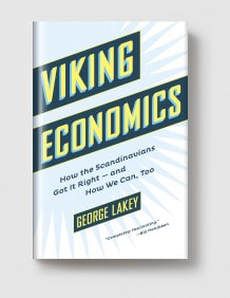Viking Economics – How the Scandinavians Got it Right and How We Can, Too
The book emphasizes how Nordic welfare systems, pensions and healthcare give people freedom: there are more start up businesses per capita in Norway and Denmark than in the US, for example as people have the freedom to take the risk of setting up their own business.

Published by Melville House, 2016
Freedom is normally a value claimed by the Right and equality by the Left. Often the two are regarded as trade offs: if you want more freedom you get less equality and vice versa. But George Lakey claims that both are delivered by the ‘Nordic model’. Lakey is writing for a US audience and starts with the contrast between the holidays enjoyed by Norwegians (at least a month) and US residents (sometimes nothing).
As well as producing entrepreneurs, the Nordic model has resulted in high levels of income and gender equality, low levels of poverty (Lakey considers that they have wiped out absolute poverty), and a good work/life balance. This has been achieved by the provision of universal services: free healthcare and education (including at university level), good public transport and pensions. While unemployment and other benefits are generous there is an emphasis on work as the way individuals can participate in society. Lakey describes the Danish ‘Flexicurity’ approach, in which rather than subsidising inefficient industries, laid off workers are given the support and training they need to get new jobs, as well as 90% of their former wages as unemployment benefit. This illustrates a key feature of the Nordic model: investment in the individual person (their health, education and training).
Another is the willingness to study problems, accepting their complexity, and act on the results of that research: evidence-based policy-making. A typical example of this, though not discussed by Lakey, is Iceland’s approach to solving their problems of teenage drinking and drug use. This has involved a range of measures, including increased provision of activities for teenagers (including football, hence, claims the mayor of Reykjavik, Iceland beat England in the 2016 European Finals), a curfew and a pledge signed by parents. But this is all backed up by an annual comprehensive survey of all teenagers to find out what life is like for them. The results of this survey are collated within a couple of months and fed back to the children’s schools and local communities, with the expectation that they are acted upon. The mayor of Reykjavik, Dagur Eggertsson says
“you have to decide what to do based on evidence and research, and secondly you have to fund it.”
A third feature is that citizens in the Nordic countries see themselves as active participants in their society, not as passive victims. This may come from the long history and strength of Nordic co-operative movements, but Lakey (on p.50) illustrates it with Icelanders’ response to the bank crisis in which they forced their government to bail out the citizens rather than the banks.
The Nordic model is, of course, is only possible with high taxes. Lakey claims that these are a price that citizens of Nordic countries, even most of the richest, are willing to pay. Rather than being a brake on economic growth, high tax countries have been shown to perform better than low tax ones, increasing international competitiveness as well as fairness and equality (p. 172). Lakey contrasts ‘Little Norway’ with ‘Great Britain’. He outlines the huge historical disadvantages faced by Norway compared to Britain: few resources, a huge land area and small population, no overseas empire. But it was the government of Britain, not Norway, which in 2013 claimed that the country was broke and took measures to reduce public spending and increase poverty (p. 173).
There are, of course, plenty of challenges facing the Nordic model. Lakey discusses immigration and climate change. Norway and Sweden in particular have been very open to asylum seekers and refugees. The population of their major cities at least has changed from being overwhelmingly white Scandinavian, to a very diverse mixture of ethnicities. Integrating this immigrant population has not always gone smoothly, and, like other countries, there are right-wing opponents of immigration. The economic growth generated by the Nordic model has an impact on the environment. Oil and gas production in Norway and industrial processing in Iceland mean their per capita emissions are high. But Sweden has lower emissions than the UK, with higher standards of living (see references below for sources of emissions). What Lakey emphasises is the Nordic’s ambitions to reduce their environmental impact: the wind turbines of Denmark; hydropower in Norway; the fact that Sweden’s emissions have fallen by 20% in the last 25 years while its economy has grown by 50%. He describes the debate in Iceland about developing hydro-power in its interior and that in Norway about Statoil’s investment in Canadian Tar sands (which it pulled out of).
The Nordic countries were not always the paragons of high living standards, welfare and equality that we see them as today. A hundred years ago they were divided, unequal societies with high levels of poverty. Now they have comprehensive employment rights, good welfare benefits, excellent public transport, good energy-efficient housing, education and healthcare, as well as culture for all in rural as well as urban areas. The transformation was only achieved through many years of struggle against the previously dominant economic elites. Lakey emphasises the role the unions played in this; strikes were common in the 1920s and ‘30s, often violently suppressed by the military. The use of the military for this purpose led many in Norway to become conscientious objectors and refuse national service. This history perhaps contributes to the pacifist role that Norway often plays today in facilitating non-violent conflict resolution. However, the ‘revolutions’ in the Nordic countries were not just achieved through industrial action. Just as important was the building of alliances, critically between urban unionised Labour and rural small family farmers, as well as political education, inclusive community organising and a co-operative movement. Social democratic or Labour parties came to power in the 1930s as a result of non-violent direct-action inspired by a positive vision of the future, not just electoral politics.
In Chapter 14 Lakey makes the case for the Nordic model being possible in the US. It is not that Americans and Nordics are fundamentally different people, who want different things. Rather, the Nordics have governments that are more responsive to the wishes of their people, while in the US it is the views of the economic elite that prevail (p. 237). The UK is closer to the Nordic model than the US: we at least have a National Health Service, paid holiday and maternity leave etc. However, there is clearly a lot further that we could go and our democracy falls short. Lakey’s account of the industrial unrest in Norway and Sweden during the 1920s and 30s made me think of 1970s Britain. In his 2009 book, When the Lights Went Out, Andy Beckett gives a picture of the ‘winter of discontent’ of early 1979 as a peasant’s revolt: numerous unofficial strikes as workers vented their pent up anger at years of pay restraint. Unfortunately, those strikes were against a Labour government, albeit one which had bought into the swing to the right which said that public spending should be curtailed. The result was not a Nordic-style social democracy, but Margaret Thatcher: a backlash against the unions and severe curtailment of their power. Is there a better chance for change now? We are clearly a divided nation, but Lakey (on p.258) argues that the greatest progress in American society was achieved at times of massive divisions. Lakey would say that we should not think electoral politics on its own is going to deliver, but we should build broad coalitions for non-violent direct action in pursuit of a vision of a better society. I think we also need to change our electoral system: the conservatives got 44% of the votes in 1979, but 53% of the seats. If seats matched votes Margaret Thatcher would not have been able to do what she did and our country would be more equal and more democratic.
When people think of socialism what often comes to mind is the authoritarian, state planning regimes of the USSR and its satellites, or of China; but perhaps we ought to think of the Nordic countries. There socialism has been a success.
For information greenhouse gas emissions by country click here.
For a breakdown of Norwegian emissions click here.
For information about Iceland's emissions click here.
Beckett, A. (2009) When the Lights Went Out: What Really Happened to Britain in the Seventies, Faber and Faber.



